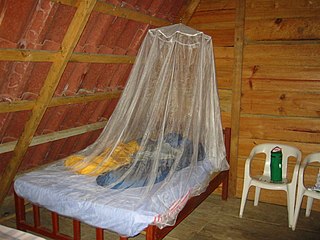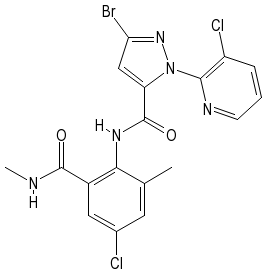Related Research Articles

Dichlorodiphenyltrichloroethane, commonly known as DDT, is a colorless, tasteless, and almost odorless crystalline chemical compound, an organochlorine. It was originally developed as an insecticide, then it became infamous for its environmental impacts. DDT was first synthesized in 1874 by the Austrian chemist Othmar Zeidler. DDT's insecticidal action was discovered by the Swiss chemist Paul Hermann Müller in 1939. DDT was used in the second half of World War II to control malaria and typhus among civilians and troops. Müller was awarded the Nobel Prize in Physiology or Medicine in 1948 "for his discovery of the high efficiency of DDT as a contact poison against several arthropods".

Insecticides are substances used to kill insects. They include ovicides and larvicides used against insect eggs and larvae, respectively. Insecticides are used in agriculture, medicine, industry and by consumers. Insecticides are claimed to be a major factor behind the increase in the 20th-century's agricultural productivity. Nearly all insecticides have the potential to significantly alter ecosystems; many are toxic to humans and/or animals; some become concentrated as they spread along the food chain.

June Foray was an American voice actress who was best known as the voice of such animated characters as Rocky the Flying Squirrel, Lucifer from Disney's Cinderella, Cindy Lou Who, Jokey Smurf, Granny from the Warner Bros. cartoons directed by Friz Freleng, Grammi Gummi from Disney's Adventures of the Gummi Bears series, and Magica De Spell, among many others.

The pyrethrins are a class of organic compounds normally derived from Chrysanthemum cinerariifolium that have potent insecticidal activity by targeting the nervous systems of insects. Pyrethrin naturally occurs in chrysanthemum flowers and is often considered an organic insecticide when it is not combined with piperonyl butoxide or other synthetic adjuvants. Their insecticidal and insect-repellent properties have been known and used for thousands of years.

A carbamate is an organic compound derived from carbamic acid (NH2COOH). A carbamate group, carbamate ester (e.g., ethyl carbamate), and carbamic acids are functional groups that are inter-related structurally and often are interconverted chemically. Carbamate esters are also called urethanes.

Paul Hermann Müller also known as Pauly Mueller was a Swiss chemist who received the 1948 Nobel prize in Physiology or Medicine for his 1939 discovery of insecticidal qualities and use of DDT in the control of vector diseases such as malaria and yellow fever.

Beauveria bassiana is a fungus that grows naturally in soils throughout the world and acts as a parasite on various arthropod species, causing white muscardine disease; it thus belongs to the entomopathogenic fungi. It is being used as a biological insecticide to control a number of pests such as termites, thrips, whiteflies, aphids and different beetles. Its use in the control of bedbugs and malaria-transmitting mosquitos is under investigation.

Fipronil is a broad-spectrum insecticide that belongs to the phenylpyrazole chemical family. Fipronil disrupts the insect central nervous system by blocking GABA-gated chloride channels and glutamate-gated chloride (GluCl) channels. This causes hyperexcitation of contaminated insects' nerves and muscles. Fipronil's specificity towards insects is believed to be due to its greater affinity to the GABAA receptors of insects, than to those of mammals, and to its action on GluCl channels which do not exist in mammals.

A mosquito net is a type of meshed curtain that is circumferentially draped over a bed or a sleeping area, to offer the sleeper barrier protection against bites and stings from mosquitos, flies, and other pest insects, and thus against the diseases they may carry. Examples of such preventable insect-borne diseases include malaria, dengue fever, yellow fever, zika virus and various forms of encephalitis, including the West Nile virus.

Deltamethrin is a pyrethroid ester insecticide.
Neonicotinoids are a class of neuro-active insecticides chemically similar to nicotine. In the 1980s Shell and in the 1990s Bayer started work on their development. The neonicotinoid family includes acetamiprid, clothianidin, imidacloprid, nitenpyram, nithiazine, thiacloprid and thiamethoxam. Imidacloprid is the most widely used insecticide in the world. Compared to organophosphate and carbamate insecticides, neonicotinoids cause less toxicity in birds and mammals than insects. Some breakdown products are also toxic to insects.

Spinosad is an insecticide based on chemical compounds found in the bacterial species Saccharopolyspora spinosa. The genus Saccharopolyspora was discovered in 1985 in isolates from crushed sugarcane. The bacteria produce yellowish-pink aerial hyphae, with bead-like chains of spores enclosed in a characteristic hairy sheath. This genus is defined as aerobic, Gram-positive, nonacid-fast actinomycetes with fragmenting substrate mycelium. S. spinosa was isolated from soil collected inside a nonoperational sugar mill rum still in the Virgin Islands. Spinosad is a mixture of chemical compounds in the spinosyn family that has a generalized structure consisting of a unique tetracyclic ring system attached to an amino sugar (D-forosamine) and a neutral sugar (tri-Ο-methyl-L-rhamnose). Spinosad is relatively nonpolar and not easily dissolved in water.

The Bell R-12 was an American 1940s military utility helicopter built by the Bell Helicopter company.

Indoxacarb is an oxadiazine pesticide developed by DuPont that acts against lepidopteran larvae. It is marketed under the names Indoxacarb Technical Insecticide, Steward Insecticide and Avaunt Insecticide. It is also used as the active ingredient in Syngenta line of commercial pesticides: Advion and Arilon.

TCPy or 3,5,6-trichloro-2-pyridinol is a metabolite of chlorpyrifos and chlorpyrifos-methyl, both organophosphate insecticides. A study in Massachusetts reported a correlation between exposure to TCPy and lower testosterone levels in men. According to this source, exposure is "widespread" and of "potential public health importance".

Acetamiprid is an organic compound with the chemical formula C10H11ClN4. It is an odorless neonicotinoid insecticide produced under the trade names Assail, and Chipco by Aventis CropSciences. It is systemic and intended to control sucking insects (Lepidoptera, Thysanoptera, Hemiptera, mainly aphids) on crops such as leafy vegetables, citrus fruits, pome fruits, grapes, cotton, cole crops, and ornamental plants. It is also a key pesticide in commercial cherry farming due to its effectiveness against the larvae of the cherry fruit fly.

The gypsy moth, an invasive species from Eurasia, was discovered in New Zealand. The gypsy moth has potentially disastrous effects on New Zealand agriculture; an intensive eradication programme was planned and undertaken, and the moth did not become established.

Triazofos is a chemical compound used in acaricides, insecticides, and nematicides.

Phenthoate is an organothiophosphate insecticide. It is used against Lepidoptera, jassids, aphids, soft scales, mosquitoes, blowflies, houseflies, and ked.

Chlorantraniliprole (Rynaxpyr) is an insecticide of the ryanoid class. Chlorantraniliprole is being developed world-wide by DuPont belonging to a new class of selective insecticides featuring a novel mode of action to control a range of pests belonging to the order Lepidoptera and some other Coleoptera, Diptera and Isoptera species.